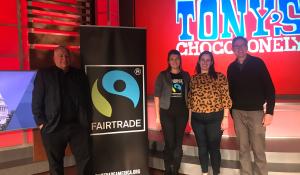
This article is an expanded Web version of a piece that first appeared in the print edition of the Green American.
High school science teacher and Green America member Joshua Barclay’s super energy-efficient home started off as a simple science experiment, trying to answer the question: Can solar panels power a home, even in cloudy Michigan?
But as he and his wife Mary Ledvina installed a solar array to power their home in Whitmore Lake, just outside of Detroit, they made that home as energy-efficient as possible. Barclay agrees with Green America’s longtime advice that before going solar, it’s vital to improve your home’s efficiency in every possible way so you’ll need fewer panels, saving money and resources.
“The energy efficiency piece, although renewables are flashy and exciting, is where you gotta start,” he says.
Barclay and his wife had already tried to cut down on electricity costs, for instance by setting the thermostat lower during the winter, when they received the original “Efficiency First!” issue of the Green American (then the Co-op America Quarterly) in 2008.
As recommended in that issue, Barclay scheduled a Home Performance with Energy Star energy audit. He and Ledvina also implemented all of the efficiency steps Green America had detailed, such trying not to heat or cool empty rooms, air-drying their dishes instead of applying the dishwasher’s “dry” setting, using power strips to turn off electronics and eliminate phantom load, keeping the refrigerator full, washing clothes with cold water, putting a blanket on their hot-water-heater, and plugging air leaks. They also implemented all the retrofits recommended by their energy auditor.
Barclay and Ledvina’s house is similar to the average American home in its size and the sorts of appliances it contains. Yet, while the average American home uses 30 kilowatt-hours of energy per day, theirs uses about ten.
Even so, their behavior and lifestyles have not changed radically, says the couple.
“I feel that a lot of things that we’ve done, I haven’t even noticed,” says Ledvina.
The solar array they installed produces 15 kilowatt-hours per day, on average (more in the summer and less in the winter). With the efficiency improvements, this figure is more than the house needs on average, showing that solar energy can power a home, even in Michigan.
Interestingly, the energy conservation steps Barclay and Ledvina took cut down on the amount of electricity their home gets from the grid more than the house’s solar array does.
“We saved more from energy efficiency than we ever saved from our solar array,” he says. “So really, the most ‘efficient’ thing is to target energy efficiency.”
TAKING EFFICIENCY TO SCHOOL
Crediting Green America with helping him make his home as efficient as possible, Barclay has also been teaching his students at West Bloomfield High School about the benefits of energy efficiency for over ten years. He started by collaborating with School District Facilities Operations Supervisor Bill Wold to have his students audit the school’s energy use.
“We didn’t do it just so we could save money,” Wold says. “The primary focus was teaching the kids about energy efficiency.”
When these audits began, appliances that measure power usage were not on the market yet, so Barclay made some of his own using ammeters and extension cords from his classroom. He and his students made a database looking at what parts of the school used the least and most amount of energy; they found that replacing light-bulbs, installing motion-sensor light switches, and turning off computers at night and over breaks could bring significant savings.
At the same time, Wold employed professional energy auditors who also found significant savings. With Barclay’s help, students presented these findings to the school board, noting how much money could be saved each month through efficiency improvements. They illustrated these savings by showing what the money could get the school district: astroturf for the field, coaches for all-female varsity teams — the list went on and on.
The school board took the energy auditors’ recommendations, and Barclay believes his students’ presentations tipped them over the edge. And so the West Bloomfield School District schools began retrofitting. They picked the “low-hanging fruit” first, Wold says, putting in new windows, roofing, and light bulbs, and they have continued scheduling retrofits to this day. The results are already having positive financial effects, with Wold and Barclay reporting savings of around $100,000 on last year’s heating and electricity bills at the high school.

As Joshua Barclay and Mary Ledvina installed a solar array to power their home, they also increased their home's efficiency.
GETTING THE COMMUNITY’S ATTENTION
Soon after the first retrofits, Barclay found grants through Michigan’s public service commission for a renewable energy project. To apply for the grant, schools had to show that they had already undertaken energy efficiency measures — just as West Bloomfield had.
West Bloomfield won one of the grants, but they charted their own course on how to use the grant money. For one, the grant specified erecting solar panels on an existing building.
“That didn’t fit our dream, because we wanted to attract people’s attention,” Barclay says. “We wanted to put it out there by itself. And we wanted it to move, because according to educational theory, the more action and motion you have in something, the more you attract people’s attention.”
Mel Barclay, Josh’s father — whom Josh credits for fueling his fervor for renewable energy — was thrilled by the idea of placing a solar array on one of the area’s busiest streets, where students, parents, and regular community members would be able to see renewable energy up close instead of through a television screen.
He offered to cover the matching funds required by the grant-making commission — enough to secure the grant, but not to fulfill Barclay and his students’ dream of a free-standing solar array whose panels followed the sun as it traveled across the sky.
“The grant was what got us interested in the project and that was really the jumping off point,” says Natalie Davenport, who was a student in the school’s environmental club EARTH (Environmentally Aware and Ready to Help) during the lead-up to the installation of the solar array . “Even with the grant, we had to raise a lot of money and jump through a lot of hoops.”
So Josh Barclay and EARTH sponsored initiated a series of fundraisers, selling collapsible, reusable shopping bags from Green America Green Business Network ™ member ChicoBags (Chicobags.com), holding organic bake sales, and getting local businesses to chip in.
“To be honest, when we first were talking about ‘Let’s get a solar tracking array,’ we knew it was going to be a long road,” says Kacie Mills, who was EARTH’s co-president during the lead-up to the installation of the solar array. She notes that Barclay’s confidence rubbed off on the group.
“He always had faith in the project, even from the beginning,” she says. “With him, you knew it was going to get done.”
The biggest fundraiser was the sale of inscriptions on the paving stones planned to rest in front of the solar array. Mills says that the club had a grid showing where each inscription would go, and she remembers her excitement each day as the grid filled up.
Before the grid was completely filled, the members of the student environmental club each chipped in some money to buy a paver, together. On it, they inscribed: “Proof that all big things start small.”
CONTINUING THE SCIENCE EXPERIMENT
The science experiments and educational exercises continue. Last year, Barclay and his students made two YouTube videos about energy efficiency: one showing how Barclay and Ledvina took the steps recommended by Green America’s “Efficiency First!” issue, and the other detailing their energy audit and the efficiency steps they made after it took place.
“We based much of the footage [from the first film] on the 2008 ‘Efficiency First!’ issue. We took all of Green America’s advice and captured each improvement item on film as we did them at my home,” says Barclay.
During the 2011-12 school year, Barclay’s students will measure whether the entire science classroom’s energy needs are covered by the school’s solar array, first by calculating classroom electricity consumption and then by tracking the array’s production. Meanwhile, the biggest sun-tracking solar array in the greater Detroit area remains a point of interest for passers-by, as does the big digital sign next to the array showing how much energy is being produced.
“While it's true that we are not powering the whole school with this array, it is a symbol of hope and change,” Davenport says. “Every day, there are thousands of people the drive by the array, and the subtle hint that a high school is doing this might plant the seed for them to do the same. The Environmental Revolution, just like every revolution in the past, is by the people and for the people.”
Despite the interest generated by the solar arrays at Barclay’s house and at West Bloomfield High, Barclay emphasizes the need to reduce energy consumption first.
“Lots of people are like, I’m going to go green, I want to go solar — but these non-flashy things like taking plugs out when you don’t need the appliances, that’s really the way to go green,” he says. “Once you’ve done those efficiency measures, then you can go solar.”
- Read more about Barclay and Ledvina’s efforts at DreamFarm.org.
- Take Green America’s recommended steps for energy efficiency from our 2008 “Efficiency First!” issue and our 2011 “Efficiency First!” update.
- View the “YouTube videos Barclay and his students made on “How to Green Your Home and Save Green for Your Wallet”







